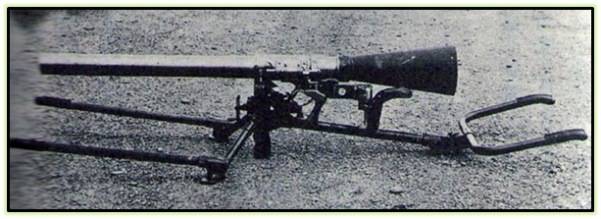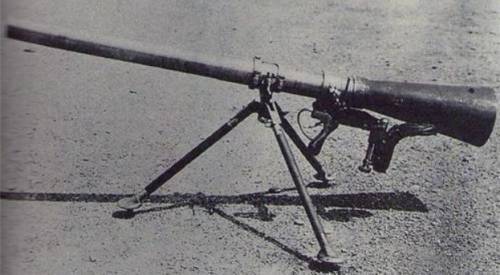
Experienced 81-mm recoilless gun
Shortly after the Japanese specialists got acquainted with the 1945-mm American wheelless M57 at the start of 18, the 81-mm recoilless gun was handed over for testing. The Japanese kickback for this caliber was unprecedentedly light. The body weight of the gun was only 37 kg, the American 75-mm gun M20 that appeared at about the same time weighed 54 kg. Initially, the 81-mm gun was mounted on the 20-mm Type 97 gun, but after the first firing it was transferred to the simplest tripod.

A cumulative projectile weighing 3,1 kg left the barrel at a speed of 110 m / s, and pierced 100 mm armor along the normal. The effective shot range did not exceed 200 m. While conducting combat operations in the jungle, this would be enough, but the downside of low weight was the low strength of the barrel. After several people died as a result of the rupture of the barrel at the test site, the 81-mm recoilless mechanism was no longer refined and the designers concentrated their efforts on the 105-mm recoilless gun. At the same time, a number of sources based on the recollections of Japanese veterans say that a small batch of 81-mm recoilless still hit the front and was used in the battles for Okinawa.
Volunteer Fighting Corps (国民義勇戦闘隊, Kokumin Giyū Sentōtai) were armed civil defense units planned in 1945 in the Empire of Japan as a last desperate measure to defend the Japanese home islands against the projected Allied invasion during Operation Downfall (Ketsugo Sakusen) in the final stages of World War II.
They were the Japanese equivalent of the German Volkssturm and British Home Guard.[1] Its commander-in-chief was former Prime Minister General Kuniaki Koiso.[2]
History
[edit]
Volunteer Corps
[edit]
In March 1945, the cabinet of Japanese Prime Minister Kuniaki Koiso passed a law establishing the creation of unarmed civil defense units, Volunteer Corps (国民義勇隊, Kokumin Giyūtai). With the assistance of the Taisei Yokusankai political party, the tonarigumi and Great Japan Youth Party, units were created by June 1945.

The Kokumin Giyūtai was not combatant, but working unit for fire service, food production, and evacuation. All male civilians between the ages of 12 and 65 years, and females between 12 and 45 years were members. They received training on fire fighting techniques and elementary first aid.
Reformation as militia
[edit]
In April 1945, the Japanese cabinet resolved on reforming Kokumin Giyūtai into civilian militia. In June, the cabinet passed a special conscription law, and named the militia units Volunteer Fighting Corps (国民義勇戦闘隊, Kokumin Giyū Sentōtai).
The Kokumin Giyū Sentōtai would be organized, if Allied landing units came close to the Japanese homeland. Governors of Prefectures could conscript all male civilians between the ages of 15 and 60 years, and unmarried females of 17 to 40 years.[1] Commanders were appointed from retired military personnel and civilians with weapons experience.
Combat training sessions were held, although the corps was primarily assigned to support tasks, such as construction, transportation and rationing.
The Volunteer Fighting Corps was intended as main reserve along with a “second defense line” for Japanese forces to sustain a war of attrition against invading forces. After the Allied invasion, these forces were intended to form resistance or guerilla warfare cells in cities, towns, or mountains.
